Lessons Learned – by Pat Carson

Is It Right Or Is It Wrong 17
It is a new year and it is time again for my latest installment of “Is It Right or Is It Wrong.” For the past eight months, I have been collecting photos of things that we know are just not right, some things we know are right, and sometimes we see things of which we are not sure. As we move into the winter season where the winds are stronger and less predictable, I want to share a few of my latest observations of marlinspike seamanship in installment 17. I do appreciate the reader submissions, as I may not see all that is right (or wrong) as I boat around the Bay and Delta.
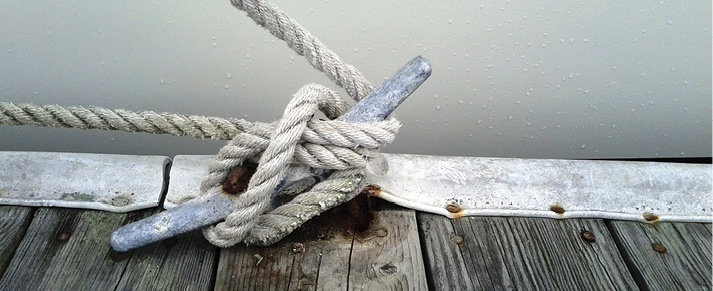
Some things just jump right out as you walk the docks in the many marinas in the Bay and Delta and along the Pacific Coast. It never ceases to amaze me at the basic lack of understanding some yachtspeople have when securing their boats to a dock. Although there is not one right way to arrange lines and fenders, there are some arrangements that work better and then there are those that are doomed to fail.
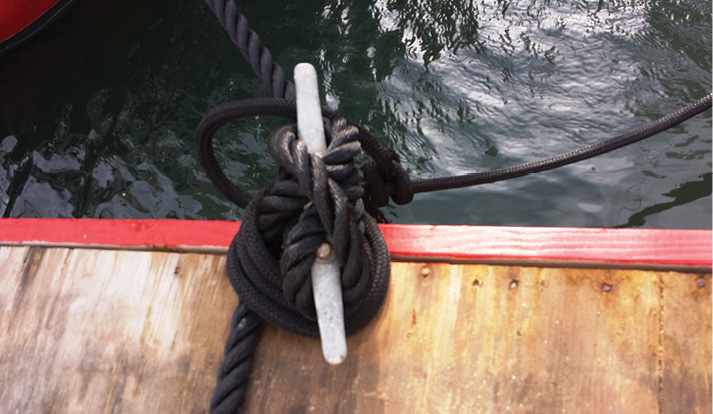
Although this is a properly tied cleat hitch and appropriately sized line, it appears the vessel is simply too heavy for the cleat and from the looks of the cleat, it was held in place with lag screws instead of being through bolted. It might be better to move either the spring or the breast line to a different cleat to spread out the load. If it is possible, it is always better to spread the load among as many cleats as possible and avoid doubling up with the possibility of overloading. This is true for both the cleats on the dock and the cleats on the boat. Both the dock owner and the boat owner did this one wrong.

Here is another cleat failure with merely one of the lag screws still holding the cleat in place. Although you cannot see it in my photo, there are two vessels using this one cleat. Both vessel owners should consider other options for securing their boats. Look close and you will also notice that neither line was tied with a proper cleat hitch. Even though the cleat appears to be properly attached with through bolts, the load was just too much and it failed. I consider this a failure on the boat owners’ part and not the dock owner.
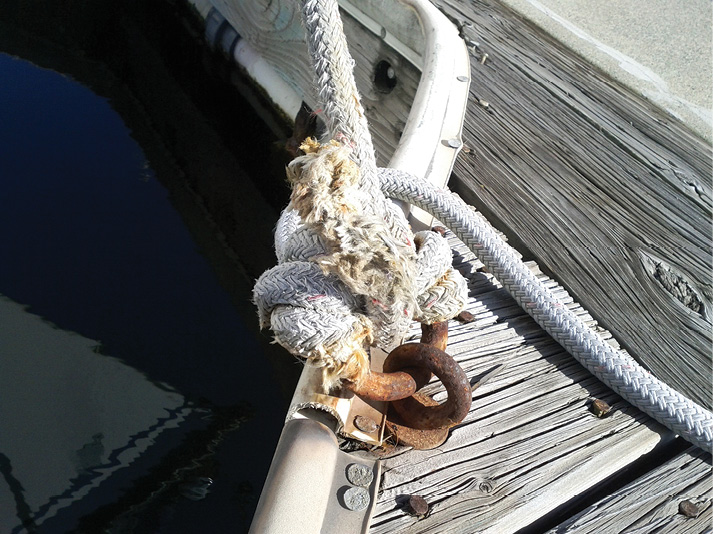
It appears the last skipper to use this cleat put too much strain on the hardware. This cleat was through bolted; however, the force of the vessel tore the backing out and pulled the cleat free. Although we do not know what precipitated this failure, I think it is safe to assume it was the boat owner that put too much load on the cleat that caused the failure. Just to confirm, it was not me.
Tying a line to a ring is more challenging than tying a line to a cleat. The most concern is the likelihood of the line chafing and parting if not tied properly. In this example the yachtperson assumed that using more knots is better and had no concern with the severely corroded ring and worn dock line. The vessel owner is putting a lot of faith into a worn-out dock line that is improperly tied to a rusted ring. It will not take much longer for this to fail, leaving the bow of the boat unsecure. A better and more secure knot would be an anchor bend after cleaning the corrosion from the ring.

What could be worse than an improperly tied dock line? How about undersized, repaired with an improper knot, and the wrong material dock line. Polypropylene line makes a poor dock line because it does not stretch, it is slippery allowing knots to easily untie themselves when worked and it has far less strength for a given diameter than nylon. In this example, the knot utilized to tie the lines together is a square knot. Again, a poor choice for the application as a square knot will untie if worked. A better choice would be a sheet bend or if you really must use polypropylene line then a double sheet bend. However, in this implementation at least the owner doubled the lines, although both lines have inappropriate bends.
Let us take a look at the other end of the dock line, the boat cleats.
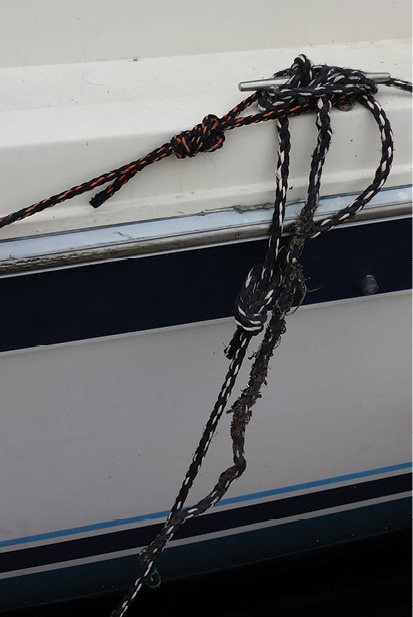
Here we go again with that polypropylene line. I know it is cheap when purchased at the outdoor laundry department at any home improvement center, but it is simply not the correct material for dock lines. Bonus points for using black electrical tape to whip the eye splice. Look closely and you can see the blue/white polypropylene line that appears to have been a fender whip that parted and now has a missing fender. There is nothing right that I can see here.

Is half a cleat hitch as good as a full cleat hitch? No, I do not think so. Under strain one of two things is going to occur, either the line will tighten around the cleat and be exceedingly difficult to untie, or it will pull through and let the bow free. In either instance it is not good practice and a longer line should be deployed. This is wrong and should be corrected.
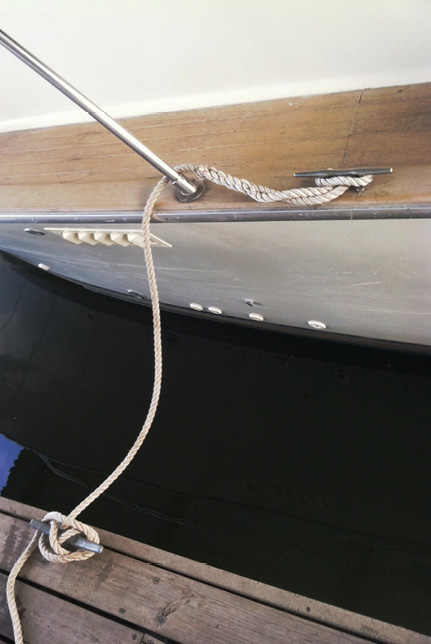
While I am being critical and picking on the unsuspecting boater, I must mention that wrapping the breast line around the stanchion usually results in a bent or broken stanchion. I have seen several instances where the mounting hardware has been compromised due to strain being placed on the stanchion then allowing water to find its way under the deck, ultimately resulting in rot or delamination. Cleats are designed to take the strain of the dock line; railing hardware is not. Working in the owner’s favor is that the line is not properly tied to the cleat and has just a few wraps around and only one figure eight. With no weather hitch this line will slip and not allow much strain on the deck hardware. Still wrong even if it will not cause damage to the deck hardware.

If you intend to use polypropylene line for a dock line, then at least having a rubber snubber of some kind will provide needed stretch. This is a well thought out example of using an old tire as a shock absorber and is a widespread practice in many marina locations with surge and wind and seems to work well. Other than the fact that this is an undersized polypropylene line, the splice is well done. The use of the galvanized steel thimble is acceptable (stainless steel would be better) and the chain attaching to the tire is sized appropriately. Well done sir or madam and my guess is, it works well in this application.
Usually, the weakest link in the ground tackle is the line to chain splice or the chain swivel if the rode is so equipped.
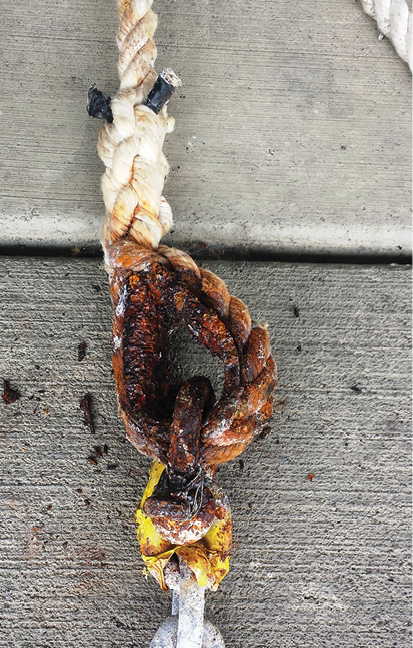
I was with a new client on his recent yacht purchase when we decided to inspect the ground tackle and mark the rode at 25-foot intervals prior to heading out for anchoring practice. Two big mistakes we found here. First is the rusty thimble. Had the previous owner used a stainless-steel thimble, this amount of corrosion would not occur. Second, although they did a near perfect back splice it has only three tucks. Minimum in this application would be five and I would do seven or even eight for a splice in a critical application such as keeping my anchor rode securely attached to my anchor. After use, the owner would be better served if the rode got a freshwater rinse and a yearly inspection. We ended up taking the time to do a new chain to line splice and the vessel’s owner learned a new skill.
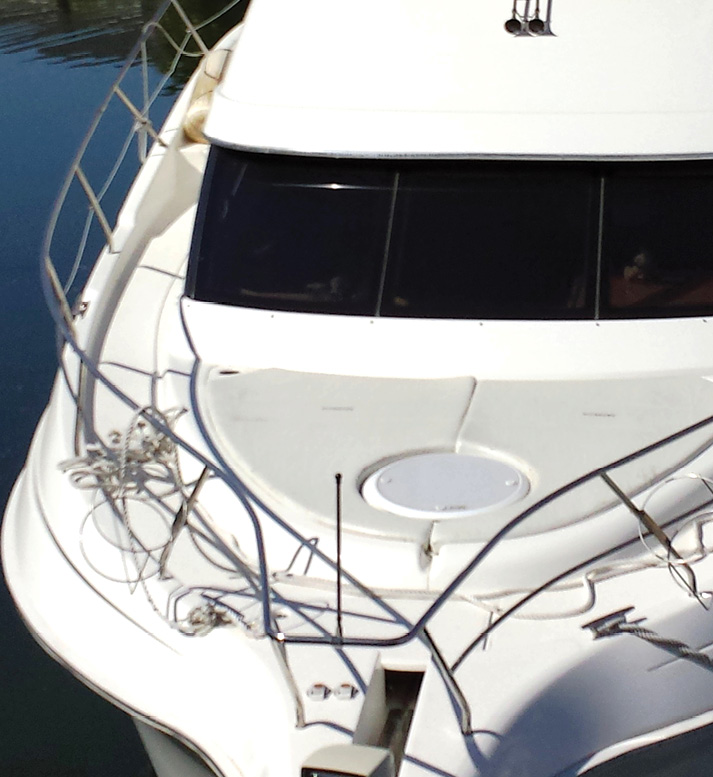
What to do with all that extra line after securing the boat? Just leaving the excess laying in a pile on the dock is definitely not the right answer.
The example leaves an abundance of extra line here, and perhaps a shorter line would be easier to dress. Although the line is of the proper type and size, this is still a fail. And considering the mismatched fenders, our yachtsperson definitely loses style points.
Piling the excess line on the boat deck is also not acceptable. In this shot, the bitter end of this standing line looks as though it was tossed on the foredeck where one of the crew could trip over it. This is not the proper way to deal with the excess dock line.

If you are simply going a short distance, then flaking on the foredeck is acceptable. If you are going out for many hours or the entire day, it would be best to remove the line, coil it and stow it properly.
Or, trying to do something with the excess in the cockpit by wrapping it around the cleat is not acceptable. Although the line is probably out of the way, there are no style points awarded here, and if the line is needed elsewhere, removing it from the cleat will take much longer and with more effort.
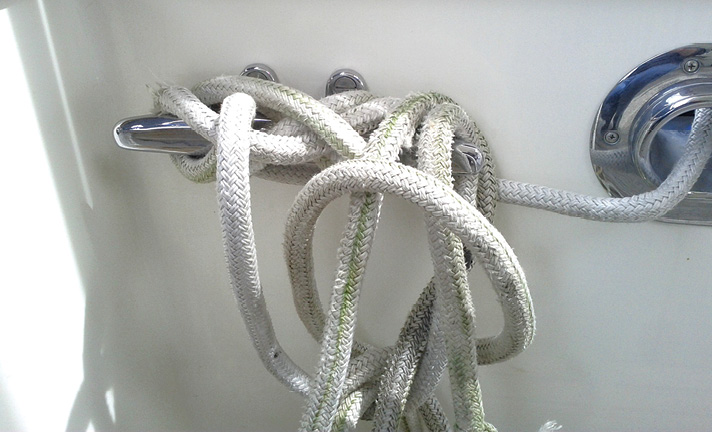
Making several figure eights on the cleat and then laying the excess on one of the horns results in a very sloppy looking hitch. This was a tangled mess and begged to be cleaned up. After securing the boat there are a lot of little items that need to be addressed. Generally, we must get the shore power set up, the water connected and a rubber mat deployed to cover the trip hazards.
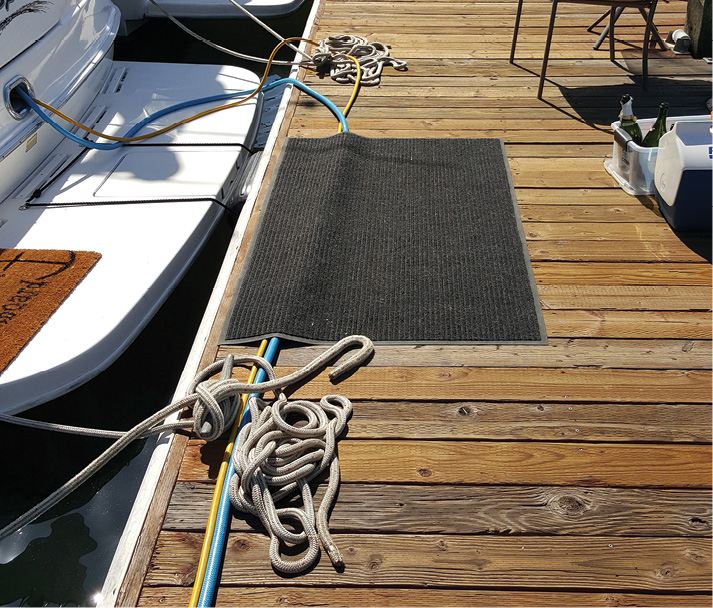
It appears this yachtsman had not finished cleaning up the line part before I wandered by and snapped a few photos. Ten minutes later the dock looked a lot neater and I got a glass of port, a cigar and a comfy deck chair in return for a promise not to say anything. Well, normally I would not say the owner’s name, but it’s been a couple of years now and that port and cigar are a distant memory along with fond memories of a dear friend. Thanks Don. Miss you buddy.
This is a nice-looking variation on an improperly tied Flemish and it has the same issues as any other improperly tied Flemish.

As the line is uncoiled it develops a twist and needs to be unwrapped before use. If the Flemish is done correctly the line will not be twisted when uncoiled to be put back into service.
Also, take a close look at how the line is tied off. It has a single wrap around the dock pipe and is then brought back to the boat where it is secured to a cleat. In calm water this arrangement may be fine, but if the weather turns that line will chafe on the pipe where it is wrapped and may weaken and part.

Same issue with this line around the cleat. With merely the single turn around the cleat, you can see that the line has already begun chafing and the outer braid of the double braid line has chafed though. Although the inner braid of the line provides most of the strength and the outer braid is primarily for chafe protection, this line is compromised and needs to be replaced.
The line is serving a dual purpose, a bow line and a forward spring line. If this line fails, not only is the bow free to the right, but the boat is also free to drift aft. Depending on the other lines used to secure the vessel, losing this line could be a problem.
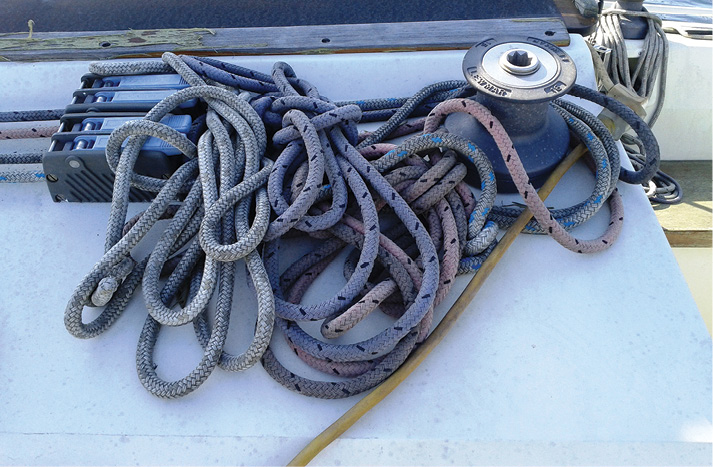
You think that all sailors know how to handle lines, store them neatly and have them ready for use? Not so, as this was just a tangled mess of dirty sun faded sheets on a midsized sailboat. Perhaps I am being too critical, but having been a sailor in the previous century, I know these can be stowed neatly.
A nice, clean and very yachtsperson-like solution is to Flemish the line. Here in this example the owner made an attempt at neatness. It is unfortunate he did not know the proper way to tie a cleat hitch or make a Flemish. Fail.
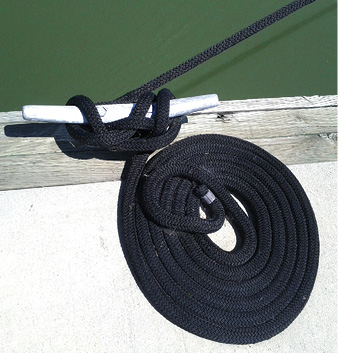
When that fender whip is just too short, one solution would be to put a brass snap shackle on the end and wrap it around a stainless-steel rail.
A metal shackle that is allowed to slide along the polished railing will surely mar the finish. If the boat resides in a saltwater environment, it does, then ultimately dissimilar metal corrosion will occur. There are many better solutions to this marlinspike failure.

When done correctly, the Flemish and cleat hitch look nice and function well. Remember, the best knot is one that is easy to tie, easy to untie and is secure enough for the application.
I did have a learning experience many years ago in Northern British Columbia. After docking my boat and securing the lines, I promptly began to Flemish each of them on the dock when an old guy walked by and mumbled “I would not do that” and kept on walking. Not understanding why, he would not Flemish the lines on the dock I finished and took pride in my work.
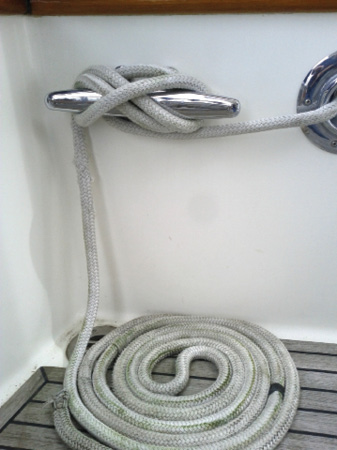
It was not until the next morning that I understood why the old guy would not Flemish the lines on the dock. As I found out, the beavers love to walk the docks at night and find a neatly coiled line to be the perfect spot to do their business. All my nice lines were totally soiled and smelled horrible. Lesson learned – better to put the eye on the dock and finish the line off on the boat where the beavers do not travel.
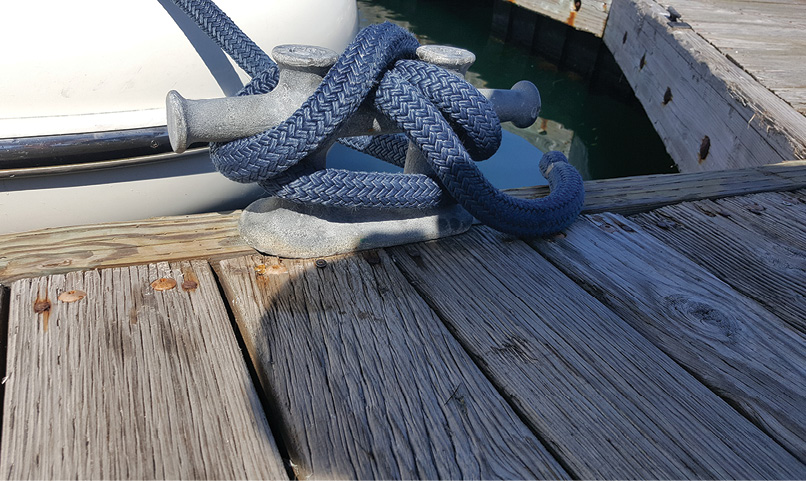
Well, that is all for this installment. Now I can sit back and enjoy that fine cigar as I consider “Is It Right or Is It Wrong? 18” for next time. And yes, that cigar is right, but since I am driving the boat, the glass of Port will have to wait as that would be wrong.
Every day as we are on our boats or just walking the docks at any marina, we see some things are clearly wrong, some that you may not be sure of and you might even find a few ideas to solve a problem you are having. This is our chance to learn a lesson or two and maybe, even get a laugh. Keep sending me those photos and I will have another installment next year.
If you have some good photos and are not sure if what you are looking at is right or wrong, send me an email and some photos to patcarson@yachtsmanmagazine.com. I may include them in the next edition of “Is It Right or Is It Wrong,” so that we can all learn from others’ experiences.



